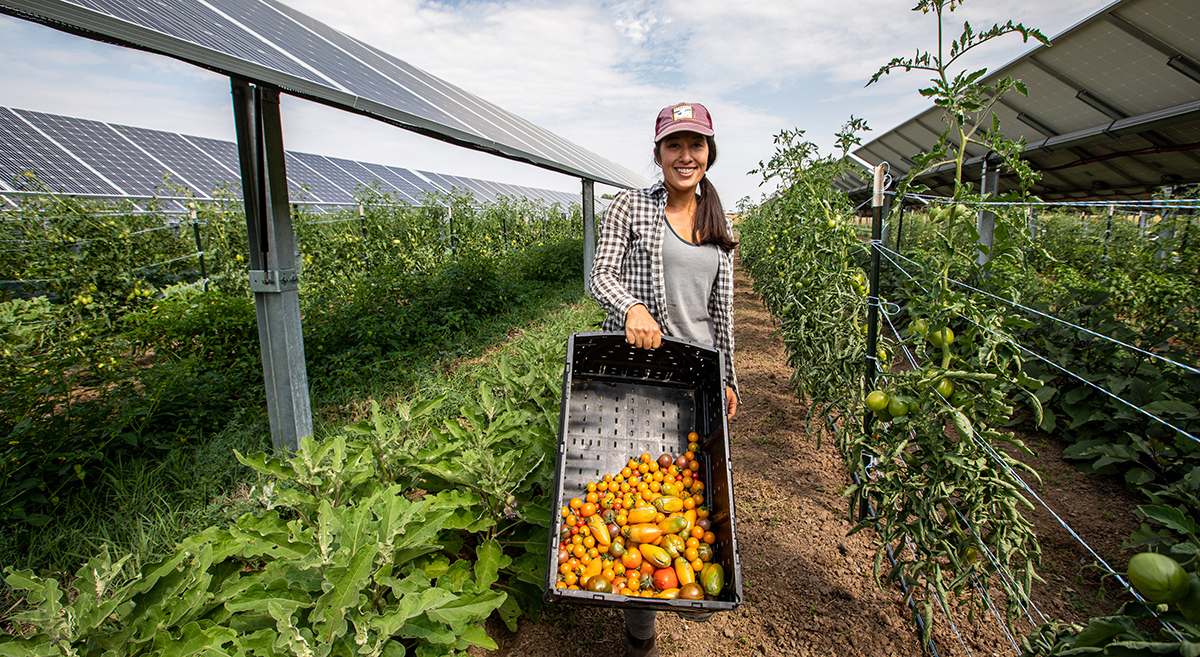Maximizing Land Use to Harvest Both Food and Electricity
Doing double-duty, layering benefits, or providing twofold results — whichever it is called — taking advantage of two positive uses on one valuable piece of land makes logical and financial sense.
That is a main purpose of agrivoltaics, or the simultaneous use of land to produce both food or agricultural products and renewable energy from solar panels. Named from the words “agriculture” and “photovoltaics,” agrivoltaics maximizes land use at a time when land prices in Colorado keep rising and making a living as a farmer or rancher remains challenging.
“Agrivoltaics is this wonderful win-win where you are producing solar energy and doing it in a way to allow the land underneath to serve a purpose,” said Elise Jones, board member of the Colorado Agrivoltaic Learning Center in Longmont that was established in 2020. “We need to steward the planet well, and we are facing a lot of changes in that regard right now with climate change and food insecurity.”
Professor Alan Knapp in the biology department at Colorado State University has studied agrivoltaics and supervised Ph.D. students in the topic for three years. Knapp said agrivoltaics is a step forward in dual uses similar to cattle grazing under wind turbines in eastern Colorado.
In agrivoltaics, ground-mounted solar panels are raised higher than usual to allow for farming activities or animal grazing on perennial grasses underneath. Although elevating the panels and hardening the electrical connections adds to initial installation costs, the gardens contribute to both clean, renewable energy production and locally grown food.
“This is the next logical combination of land use and renewable energy that economically benefits the landowners,” Knapp said.
The professor believes grazing for sheep and cattle could be a prime use of agrivoltaic installations in Colorado. He calls the industrial model of gravel under panels inside a fenced-off solar garden a worst-case scenario because the land does not remain functional for other uses.
Advocates and researchers point to a variety of positive benefits of agrivoltaics, sometimes called agrisolar, such as earning money from electricity production to help keep agricultural families in business on their land. The solar panels provide shade for animals, plants, and farm workers and may reduce crop irrigation requirements with less heat stress.
Ellen Kutzer, general counsel with Colorado Solar and Storage Association, calls agrivoltaics “one potential solution” for land use planning conflicts through the co-location of solar on ag lands.
Cattle owner Andy Breiter, left, brings livestock to Jack’s Solar Garden in September 2022, pictured with Jack’s owner Byron Kominek, right. Photo courtesy of Colorado Agrivoltaic Learning Center.
On the other hand, agrivoltaic projects do not work everywhere due to similar constraints as traditional solar field projects. Experts say an agrivoltaic installation is best located near appropriate electric transmission lines and near areas of electricity needs such as at the edges of urban development. Solar field developers may need to be more flexible in their traditional installation and financing models to work in agrivoltaics: including avoiding soil compaction during construction and possible spacing of rows of panels farther apart to allow for machinery to drive between.
“We really want to allow for creativity both in the technology and in the industry and figure out what kind of projects will be buildable,” Kutzer said.
Denver Botanic Gardens is planning a 1.2-megawatt agrivoltaics project for installation in March to June 2024 on 4.5 acres at Chatfield Farms in Littleton. The project at the 700-acre historic farm is a collaboration with several partners, including National Renewable Energy Laboratory. The project will provide electricity for low-income housing in Denver as well as the production of mixed vegetables, herbs, and fruit for community supported agriculture.
Byron Kominek and his partner Alexa Hapgood in summer 2022 at Jack’s Solar Garden. Photo courtesy of Colorado Agrivoltaic Learning Center.
The Colorado legislature is working to support agrivoltaics, too, with the passing of a measure that authorizes the Colorado Department of Agriculture’s Agricultural Drought and Climate Resilience Office to award grant funds for new or ongoing agrivoltaic demonstration or research projects.
One of the largest existing agrivoltaics research centers in the U.S. is Jack’s Solar Garden located just south of Longmont. The approximately 5 acres of solar panels at Jack’s creates a 1.2-megawatt community solar garden that is large enough to power more than 300 homes.
Through its companion Colorado Agrivoltaic Learning Center, Jack’s is home to educational tours, classes, research studies, and food production through urban agriculture nonprofit Sprout City Farms. The solar farm partners with researchers from CSU, NREL, and University of Arizona to learn, document, and teach about the best ways to co-locate solar panels with agriculture.
The Colorado Agrivoltaic Learning Center hosts public tours at Jack’s, with prior reservations, at 10 a.m. on Saturdays through October 7. The center will host a three-day Solar Developer Agrivoltaic Workshop September 20–22 at Jack’s and NREL with information on the Events page at www.coagrivoltaic.org.
Suzie Romig is a degreed, award-winning journalist who lives near Steamboat Springs and has lived, worked, and explored in Colorado since 1990.

